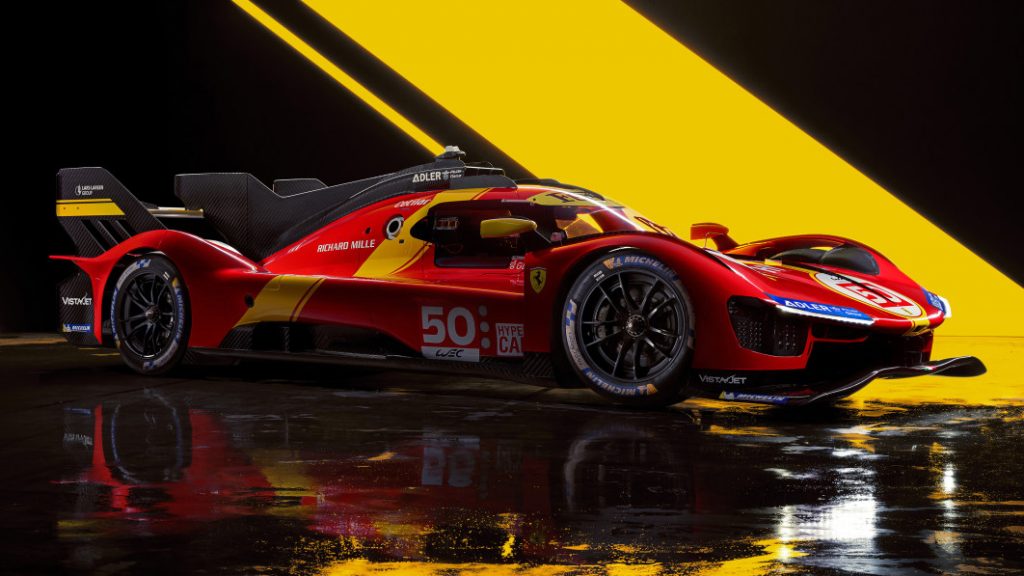Ferrari 499P revealed, takes Maranello back to top-level endurance racing

This is the international endurance racer picking up the torch Ferrari put down 50 years ago when the factory-backed 312 PB turned off its engine at the end of the 1973 season. After 18 months of preparation, the ladies and gentlemen in Maranello have served up this, the 499P for the World Endurance Championship (WEC) Le Mans Hypercar class (LMH).
It will commence racing next year in the top flight, by 2024 competing in a field counting Glickenhaus, Peugeot and Toyota in LMH, and Acura, Alpine, BMW, Cadillac, Lamborghini and Porsche in the U.S.-based equivalent Le Mans Daytona Hybrids (LMDh). Ferrari will naturally be looking to win as many races as possible, but it especially wants to add to its tally of nine overall victories in the 24 Hours of Le Mans, the last one earned in 1965 when Masten Gregory, Ed Hugs and Jochen Rindt took the checkered flag in a 250 LM.
Ferrari chose LMH because those rules allow the manufacturer to build the entire vehicle, whereas LMDh mandates a spec chassis and some spec components. Behind the 499P’s custom carbon fiber monocoque, Ferrari designed a 2.9-liter twin-turbo V6 that began with a 120-degree architecture evolved from the engine in the 296 GT3 race car and 296 GTB road car. This is where the new racer’s name comes from, each cylinder displacing 499 cubic centimeters, the P standing for prototype. The architecture is about all the three cars have in common, though. The mill in the 499P and the seven-speed sequential transmission attached to it are stressed units, meaning it’s part of the structure, unlike the engines in the other runners. This required a different philosophy in the details, resulting in the 499P engine not sharing parts with its racing siblings.
The regulations cap output at 680 horsepower, so that’s what the engine makes. It will be assisted by a 268-hp electric motor turning the front wheels. Ferrari tapped all of its programs for contributions to the 499P, the Formula 1 team providing the know-how for the Energy Recovery System (ERS). The ERS recoups energy from the Brembo brake-by-wire system to charge the 900-volt battery pack connected to the e-motor. Class rules cap maximum combined output for the car at the same 680 hp as the ICE, so the powertrain control unit constantly adjusts how much the ICE and e-motor provide. To prevent an all-wheel-drive shootout out of slower corners, LMH rules dictate the e-motor can’t contribute until the car reaches 74.6 miles per hour (120 km/hr), which is why the ICE alone can produce the combined drivetrain output.
The 499P has done more than 7,500 miles of testing so far. We’ll see it here during WEC pre-season testing in March next year, supposedly dressed in colors inspired by the 312 PB that conquered Sebring in 1972 with Mario Andretti and Jackie Ickx at the wheel. Super Sebring weekend takes place the following weekend, March 17, 2023. That’s where the WEC opens its calendar with the 1,000 Kilometers of Sebring alongside IMSA’s 12 Hours of Sebring. Ferrari will run two cars with longtime endurance racing partner AF Corse, car #50 celebrating the semicentennial return to such competition, car #51 recalling one of the most successful numbers on racing Ferraris.
The automaker hasn’t said who the drivers will be, nor whether it will run teams in the IMSA WeatherTech SportsCar Championship. It’s also being secretive about whether it will sell the 499P to customer teams, but the head of the GT program said that during development, “We took into consideration Daytona, we took into consideration Sebring, of course because it’s also part of WEC, but, all the other tracks like Road Atlanta are most important out there in our mind.”



